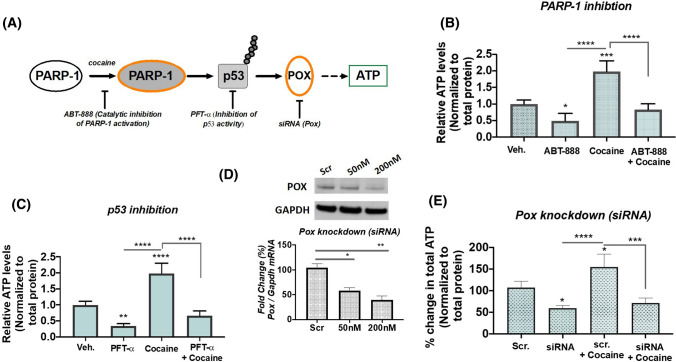Fig. 5.
Cocaine-induced PARP-1-p53-POX signaling in differentiated neurons. A Schematic depicting the experimental approach to validate cocaine-induced PARP-1-p53-POX axes in maintenance of intracellular ATP levels. B Pharmacological inhibition of PARP-1 activity limits cocaine-induced ATP production. Differentiated SH-SY5Y cells were pre-treated with PARP-1 inhibitor ABT-888 (10 µM) for 1 h followed by treatment with cocaine at (100 µM) for 24 h and the ATP levels were measured. Data shown here are average of n = 3 independent trials in duplicates, one-way ANOVA, multi-comparison analysis with Tukey’s test, *p < 0.05, ***p < 0.001, ****p < 0.0001 for relative ATP levels under ABT-888 treatment. C Inhibition of p53 transcription activity suppresses cocaine-induced ATP production. Differentiated SH-SY5Y cells were pre-treated with p53 inhibitor α-pifithrin (10 µM) for 1 h following which the cells were treated with cocaine (100 µM) for 24 h and the ATP levels were measured. N = 3, independent trials, one-way ANOVA, multi-comparison analysis with Tukey’s test, **p < 0.01, ***p < 0.001, ****p < 0.0001 for the comparison of relative ATP levels under p53 transcriptional inhibition. D siRNA mediated POX knockdown. Differentiated SH-SY5Y cells were transfected with either POX siRNA or scrambled control siRNA as indicated for 24 h. Representative immunoblot showing the dose response inhibition in POX protein levels in differentiated SH-SY5Y cells. One-way ANOVA, multiple comparison analysis with Tukey’s test, *p < 0.05, **p < 0.001 for downregulation of normalized POX protein expression relative to scrambled control. E Genetic knockdown of POX prevents intracellular ATP production. ATP levels were measured in cells treated with (siRNA-POX) and without (scrambled) knockdown of POX expression for 24 h following cocaine treatment at 100 µM for 24 h. Data presented from n = 3 independent trials in duplicates with one-way ANOVA, multi-comparison analysis with Tukey’s test, *p < 0.05, ***p < 0.001, ****p < 0.0001 for the comparison of relative ATP levels between the experimental groups

